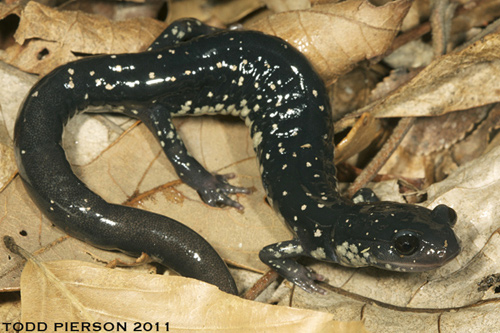The northern slimy salamander is a member of the lungless salamander family. Adult salamanders in this family do not have lungs but take in oxygen through their skin. Northern slimy salamanders are smooth-skinned and are black with white or cream marbling or speckles. They can be 7-8 inches long.
The range of the northern slimy salamander is in the eastern US from southern New York and Pennsylvania to northern Florida. There are some isolated populations in New Hampshire, Louisisana and Texas. They only exist on the western edge of Connecticut in northwestern Fairfield County. They are very rare and are listed as a Threatened species in Connecticut.
Adult northern slimy salamanders are terrestial and prefer mature forest with alot of ground debris and cover. They live under leaf litter and logs. They may come to the surface to hunt when it rains. They are nocturnal. Adults overwinter underground.
Northern slimy salamanders are believed to breed in the spring and again in the fall. 4 to 12 eggs are laid under rocks, logs or in burrows. The female guards her clutch until hatching which takes about 3 months. The spring-laid eggs hatch around August. The larval stage of these salamanders occurs inside the eggs. There is no aquatic stage, the salamanders hatch out as miniature adults that will mature in 3 to 5 years.
Northern slimy salamanders eat small insects and invertebrates.
Northern slimy salamanders get their name from their defense system. A threatened salamander exudes a glue-like substance that sticks to hands or predator mouths. While the predator is trying to remove the sticky stuff, which can collect leaves and debris to make quite an annoying mess, the salamander can escape. The goo is hard to wash off of hands.
